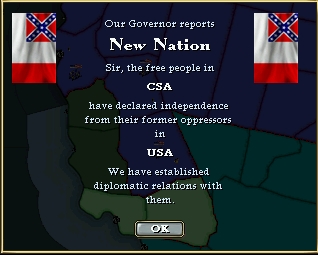Part 11: , part 3
Chapter 4, part 3
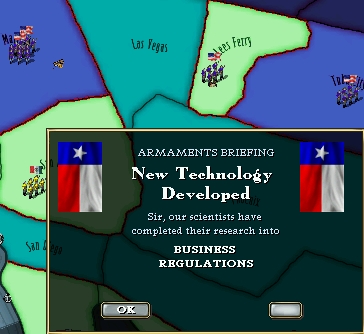

While American forces begin to seize Lee's Ferry and march into what remains of Mexican California, research into Business Regulations is complete, and work begins on Phenomenalism.
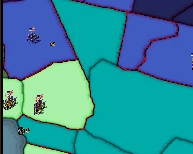
Not much later, Lee's Ferry is captured and Americans have defeated the Mexican troops guarding Los Angeles and San Bernardino. Mexico cannot put up a very good fight in its seperated territories unless it tries to mount sea-based assault.
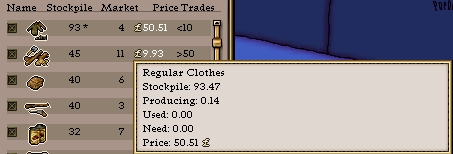
We notice that we have not been selling the clothes we are making due to clerical error and have instead been stockpiling them. We correct the error, and though the price of clothes dips sharply for a few days as we dump our stockpile onto the market, we still get a hefty profit and should now be bringing in more money.
(the world market is pretty fun to observe over the years and during certain situations, ie military supply prices go up during wars due to actual demand for those, oil starts off at like £0.50 a unit but is a cash cow by the games end, etc)
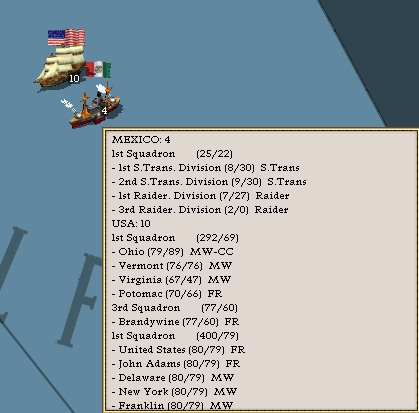
A naval battle is sighted off the coast of Galveston. Four Mexican ship squadrons, two raider and two transport, were heading toward the US southern coast but were intercepted by a fleet of US capital ships: three frigates (the Potomac, Brandywine and United States) and seven men-o-war (the Ohio, Vermont, Virginia, Deleware, New York, Franklin and John Adams). The Mexican raiders, begin more technologically advanced than the sail ships, put up a good fight, but lose to superior numbers.
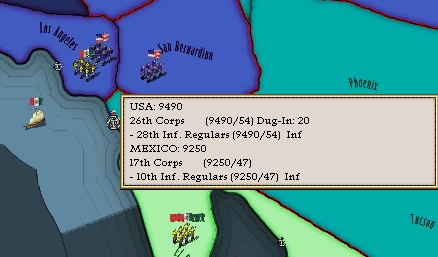
Mexico is able to land troops in Los Angeles though. Mexican clipper transports ferrying troops from El Rosario around San Diego and to Los Angeles.
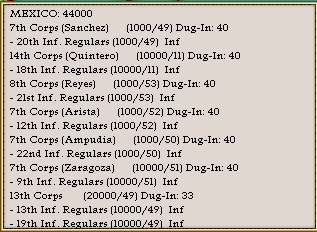
The Mexican army in El Rosario would be able to actually put up a fight if it could just march through Texas. Mexico won't declare war on Texas; they realize that it would only open the way for thousands of American troops to easily assault Mexico.
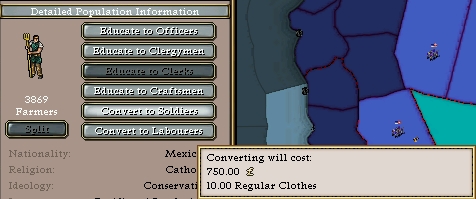
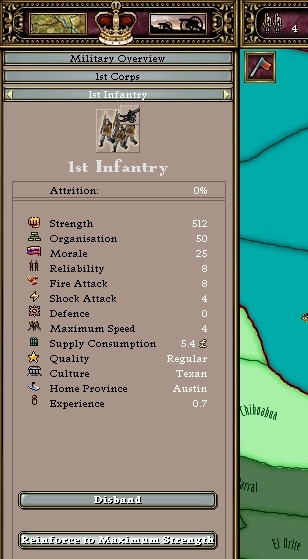
More farmers are drafted into the army, and we use what manpower we have now to send reinforcements to the 1st Infantry division in Austin.
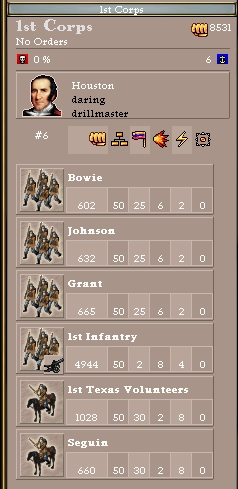
General Houston's reinforced 1st Corps. 85 hundred men, about how many we had at the beginning of the revolutionary war.
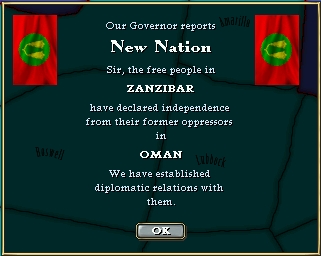
Zanzibar declares its independence, but honestly we couldn't care less. Just another African country to get eaten up by European imperialism.
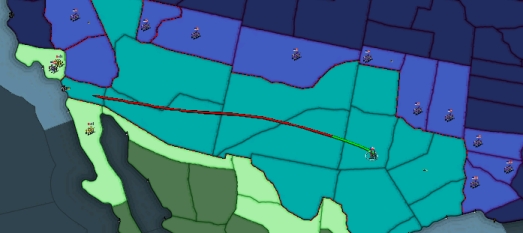
Houston is ordered to have his men moved to San Diego; in the meantime the second battle for Los Angeles is happening. The Mexicans won the previously mention battle there and retook LA and landed some more troops there.
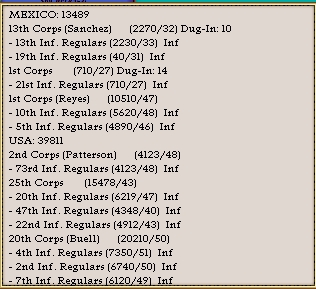
Mexican General Sanchez's men cannot hold against the forces of Generals Patterson and Buell, and the Mexicans inevitably lose that battle and the Americans capture LA once more.
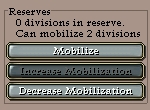
The previous account of the number of forces that can be mobilized if needed is reported to have been incorrect, and indeed only half the number of men are actually prepared. (Mobilization pools are built up in increments of 4 but I think my cap was 2 all along and it corrected itself after a while)
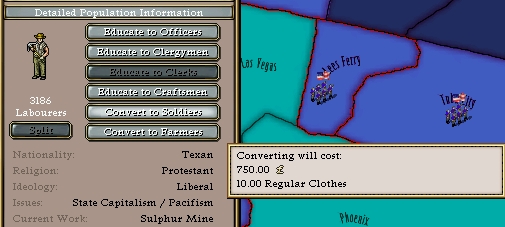
More able-bodied men are recruited, this time from the sulphur mines. We produce plenty of sulphur to supply the fertilizer factory and sell some raw on the market, so we can spare some miners to further our military.
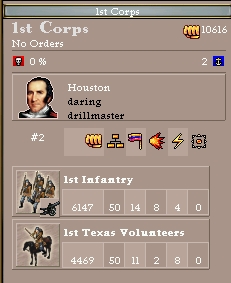
Houston's 1st Corps is reorganized and reinforced. Our army is approaching the most number of troops we can afford to keep standing; we would need a sudden large influx of immigrants to hope for anything bigger.
Phenomalism is completed, and we continue to research some rather dull cultural ideas. If we had focused on culture earlier they would actually be a boon to prestige, but most of the civilized world surpassed us in that area while we focused on industrial and economic concerns.
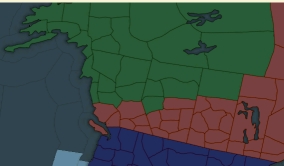
The Crimean-Canadian War continues, and Russia is taking large swaths of land in the north. We hope for Britain's sake that they are overextending and do not actually have enough men to take all of Canada.
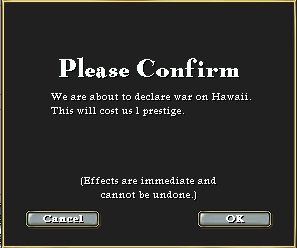

On July 27, 1856, the Republic of Texas issues its first war declaration, against the Kingdom of Hawai'i, without much ado. The Kingdom had experienced a nasty bankruptcy before and is uncivilized, so the rest of the world does not look very poorly on us for it (bad credit rating is a leading cause of annexation)
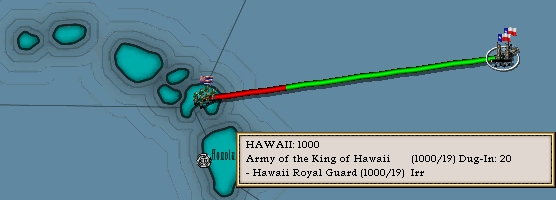
Houston and his men, who've been waiting off the coast of the big island, receive their orders and launch the invasion of Hawaii.
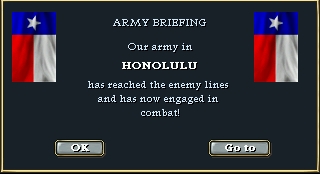

The Battle of Honolulu commences. Experienced General Houston has tenfold the men of Hawaiian leader Akau, our forces are superior and we have artillery, but they have the superior position and use of terrain, so this will be a long battle.
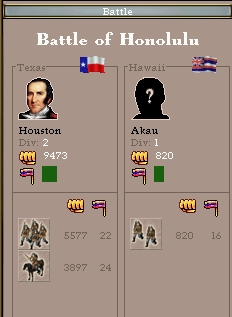
This is the situation a month later. Houston is having trouble driving the natives from their defences.
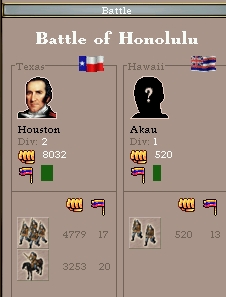
Another month of fighting goes by, and half the Royal Guard is depleted. Houston has lost 2000 men already, but we are committed to winning this. Losing a battle against Hawaii would make us the laughing stock of North America.
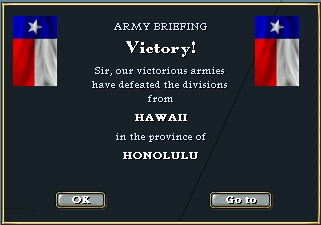
The Battle of Honolulu, which began in mid September, ends shortly after New Year's Day. The Hawaiian forces were masters of their terrain, but stood no chance against superior numbers and artillery. We suffered more than our fair share of losses, and at the end the 1st Corps had been reduced to 6500 able-bodied men.
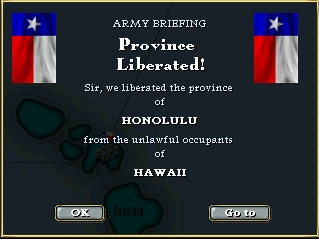
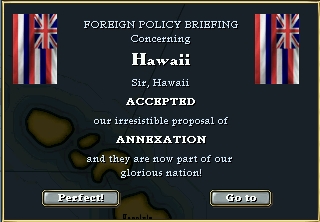
The city of Honolulu is captured, and the Hawaiian government surrenders.
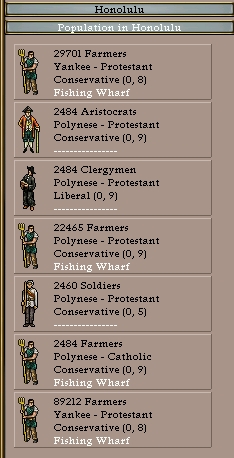
We conduct a quck census of the isles, and we learn that there are a large number of Yankees living on the island. The total population of the islands rivals that of the rest of the Republic, at roughly five hundred thousand.

April 10, 1857 marks the end of the 2nd American-Mexican War. The war was growing increasingly unpopular in America, and neither side could mount a successful amphibious invasion, or even ask Texas permission to cross its territory. Mexico was unwilling to concede the Californian cities or even Lee's Ferry, so the US reluctantly agreed to a white peace.

Houston, defender of the Republic and hero of Honolulu, returns with his men to San Diego, where they are greeted with open arms.
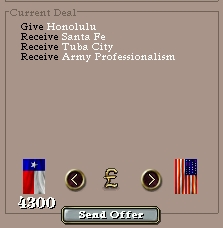
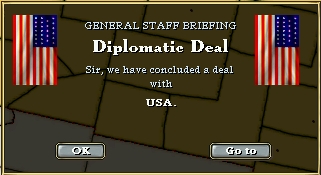
The Texan government quickly loses sight of Lamar's Pacific manifest when it learns of how interested the US goverment is in the island chain, and a deal is brokered. Santa Fe and Tuba City are added to the states of New Mexico and Arizona, the US teaches us of new methods of military conduct, and the US sends a support package of £3800 in return for the islands. Their Yankee brethren in Hawaii are more than pleased to join them.
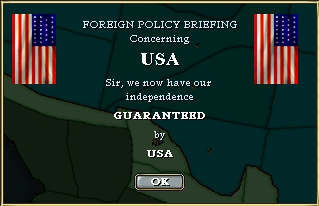
The US announces it has renewed its guarantee of Texan independence and vow to defend the Republic against foreign intrusion.
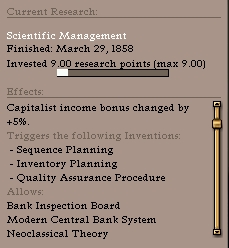
Research begins on Scientific Management methods in business, which should benefit our capitalists, the foundation of our economy, greatly.

The latus census number for the Republic. Craftsmen have overtaken slaves as the 3rd largest job demographic.
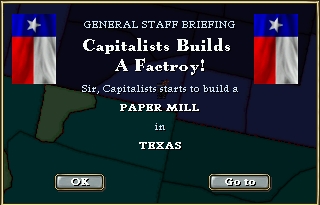
Our capitalists announce construction on a paper mill in Texas. We are not sure why they choose to produce paper, as we don't produce lumber or even timber, but paper keeps a stable decent price and we are happy to have industrial advancement in the Republic.
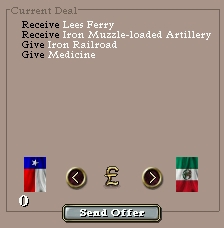
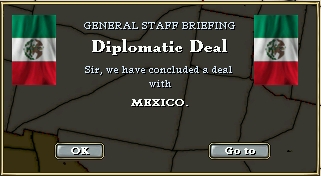
We conduct an exchange with Mexico, whom we still are keeping good relations with. They are wary of accepting the deal, but we convince them of the worth of iron railroads and medicine and that Lee's Ferry, completed surrounded by Texas and the US, is not worth the hefty price they have been asking for it in the past. We notice that Lee's Ferry produces timber, which is turned into lumber, which is used to make paper (among many other things). Our capitalists must have great foresight.
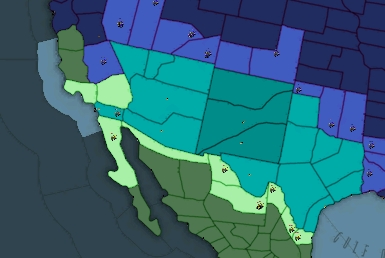
The new, cleaner border situation in the southwest.
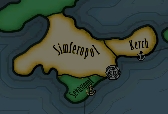
The Sardinians are making progress in Crimea. We can only wonder where the French and Ottoman forces are in all this.
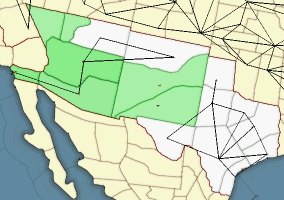
The capitalists have been disregarding railroad construction in New Mexico it seems. We hope they get to it; having a railroad stretching from the Pacific to the Gulf of Mexico would be a great benefit to troop mobility in Texas.

The Ottomans and Russians have signed a white peace. The Crimean-Canadian War has escalated far beyond its initial ramifications.
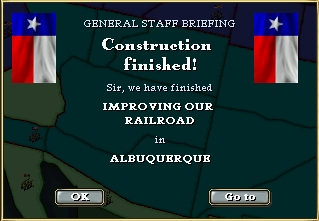
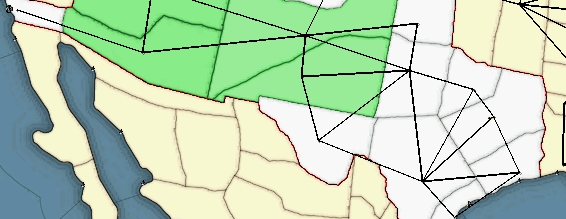
The Gulf-Pacific Railroad is completed, and a ceremony is held in Albuquerue where General Houston is invited to drive the last nail. Houston drunkenly misses the nail and smashes President Lamar's foot, but Houston is too popular to blame and the papers report Lamar as having tripped over the rails.

Mexico, frustrated with having been in a series of losing wars, declares war on the USCA. The Central American federation has been receiving immigrants from Europe, but its armed forces, in all likelyhood, will not be able to hold against Mexico's superior numbers.
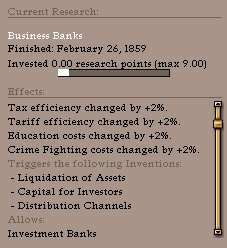
With Scientific Management completed, we begin studies into Business Banks.
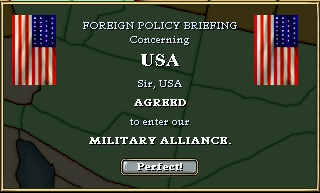
The Texan government establishes an arrangement it has been seeking with the United States since the original revolutionary alliance expired many years ago. The US has been pleased with Texas lately but does not want there to be a sizeable neutral state between it and Mexico should war occur again.
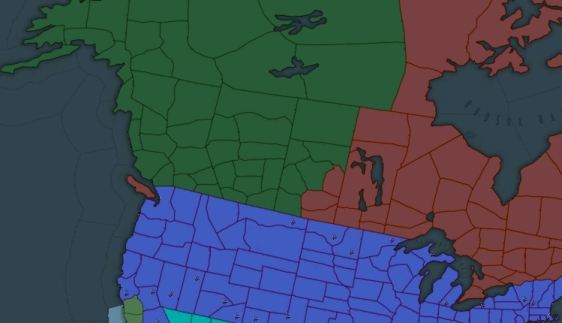
Over half of Canada is under Russian control, and Russia is showing no signs of letting up soon.

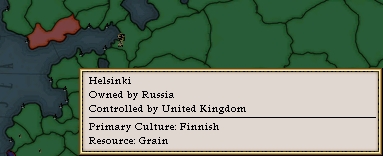
In fact, the Italians have even been driven out of Crimea. The UK appears to be winning in the Baltic theater and has captured the Finnish city of Helsinki. The Russians would be stupid to leave an area so near St. Petersburg undefended and will likely push the British out of Finland soon.

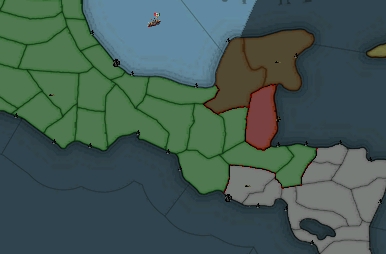
The Mexicans settle with the Central Americans for a handful of the USCA's northern provinces.
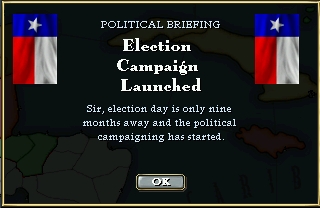
The election cycle for the Republic begins again. Lets look at the poll-
